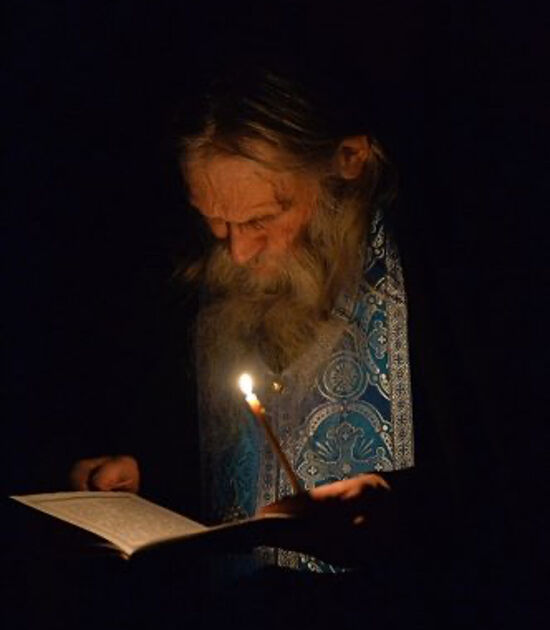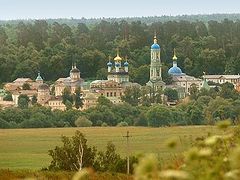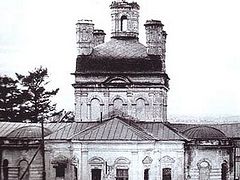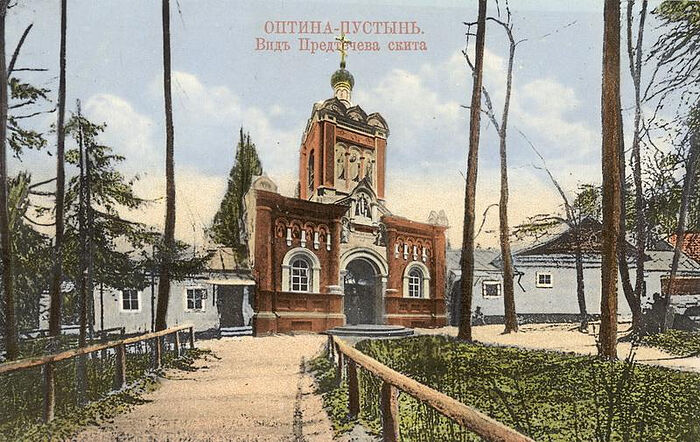 Entrance to the Skete of St. John the Forerunner, Optina. Archival photo: Optina.ru.
Entrance to the Skete of St. John the Forerunner, Optina. Archival photo: Optina.ru.
You are seized with awe when think about how sacred is this earth—this tiny plot of land in Russia on which sits the St. John the Forerunner Skete of the Holy Entrance Optina Monastery! Not by stone or wood is it compassed about, preserving the grace-filled world of Christ despite the catastrophic turn of historical events, but living, unceasingly prayer that reaches the heavens—the prayers of the great and saintly Optina elders, the many generations of monks who lived here, and the pilgrims who gathered here from all corners of Holy Rus’. The Skete was the heart of Optina Monastery—a place where the pulse of its life throbbed, from which emanated the grace-filled power that illumined the life of those who resided within it.
 An old engraving. View of the Forerunner Skete. Photo: Optina.ru.
An old engraving. View of the Forerunner Skete. Photo: Optina.ru.
The beginning of hermetic life in the Skete was placed by Schemamonk Ioanniki, who lived in the early nineteenth century in the depths of the monastery’s forest on a small apiary. Six years after his repose a group of desert dwellers from the Roslavl Forest settled there, amongst whom were Elders Moses and Anthony, who were entrusted with arranging the Skete. Fr. Moses and the brothers were faced with enormous labors: They had to clear a large area of its centuries-old pine trees in order to build a skete. Both brothers, Fr Moses and Fr. Anthony, alongside hired laborers felled the pine trees and uprooted the trunks. Gradually, separate little houses with monastic cells appeared around the church. Fruit trees were planted along with cedar nuts, which grew into graceful trees and produced fruits twenty-five years later.
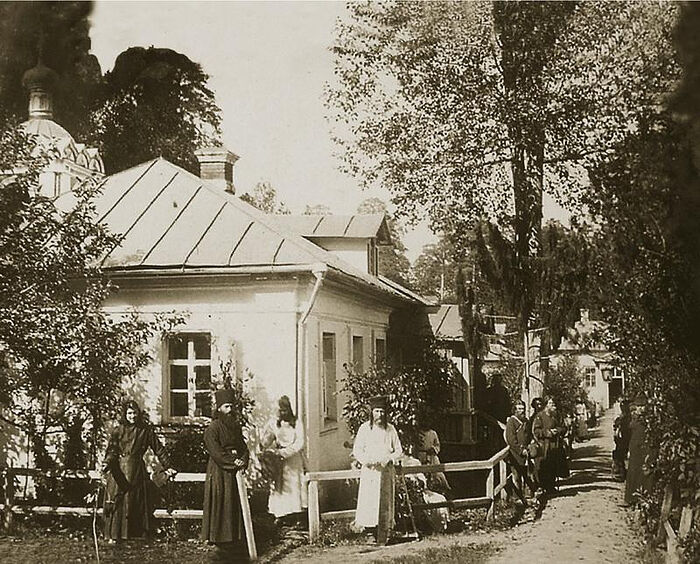 Inside the Skete. Archival photo: Optina.ru.
Inside the Skete. Archival photo: Optina.ru.
It was in the Skete that eldership was born, but St. Moses was overwhelmed with the complicated duties of an abbot, while St. Anthony was too physically infirm to take upon himself the work of eldership. This required a person who was experienced in the spiritual and ascetic life, who possessed the gift of discernment, who was firm and bold, and able to overcome all the obstacles on this path. Elder Leo was just such a man.
The early 1840s can be considered the period when eldership reached its fulness. It was strengthened thanks to the work of St. Macarius, and reached its height under St. Ambrose. It was the grace-filled spiritual guidance of eldership that drew so many people to the Skete from all walks of life. How many tears were shed there, how many sincere confessions, how many demonic webs were torn apart, how many bright hopes were reborn in people’s hearts there! The people’s love for the elders was immeasurable. Simple folk came to them with complete trust, and turned to them with all their spiritual and domestic needs. This is why the stream of visitors seeking counsel and consolation from the God-bearing Optina elders never dried up, and that is why Optina Monastery became so famous all across Holy Russia.
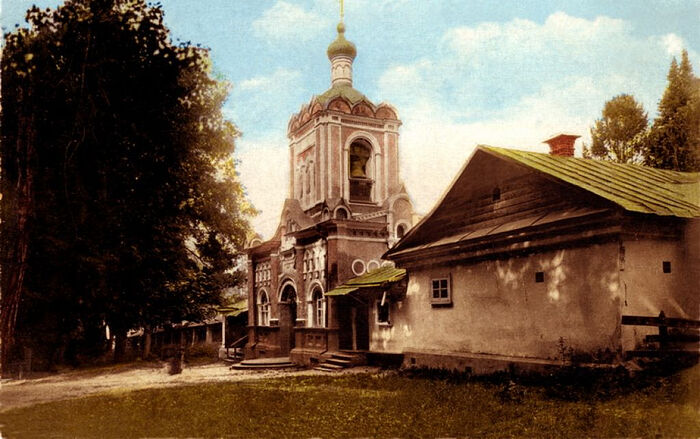 The entrance to Elder Ambrose’s “hut”. Archival photo: Optina.ru.
The entrance to Elder Ambrose’s “hut”. Archival photo: Optina.ru.
The Skete’s outward appearance was rather accurately portrayed by Feodor Dostoevsky in his novel, Brothers Karamazov. A small rose-colored belfry made of brick stood over the holy gates; on two sides, outside the walls, were the “huts”—reception rooms where the elders came out to talk with women, since they were forbidden to enter the Skete. Silence reigned within the Skete walls. This was a beautiful garden, filled with multi-colored flowers growing around the church and cells. In these conditions did Russian eldership cultivate its best spiritual fruits over the course of nearly a whole century. And today, the Skete does not cease to attract with its grace-filled and prayerful quietude a multitude of pilgrims seeking spiritual nourishment and wise counsel, just as it did over a hundred years ago.
 A modern-day view of the Skete. Photo: Optina.ru.
A modern-day view of the Skete. Photo: Optina.ru.
Everyday life in the Skete of St. John the Forerunner
The cycle of services
The cycle of services in the Skete begins with Midnight Office, which starts at two a.m., then Matins and first hour; this service lasts about three hours. Elder Barsanuphius ascribed particular significance to nighttime prayer. He said to St. Nikon of Optina that “the whole life of the Skete is upheld by the morning services.”
After nighttime prayer the brothers depart to their cells for a brief rest. They arise at 8:00 a.m. At 8:30 the brothers gather in church to read the morning prayers, third and sixth hours, and the Typica. After this the skete brothers begin their obediences.
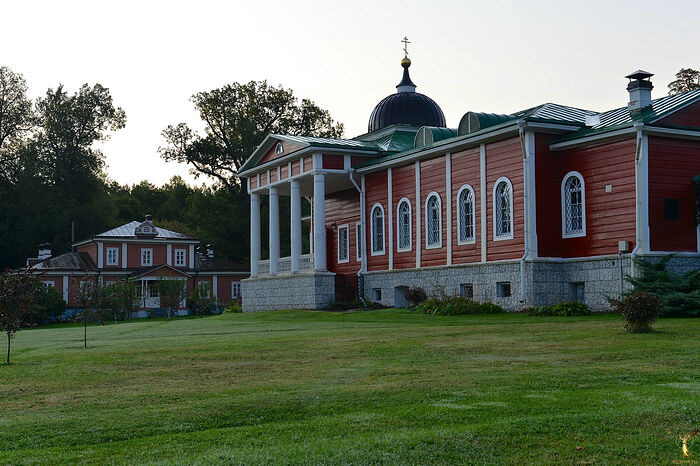 The Skete Church. Photo: Optina.ru.
The Skete Church. Photo: Optina.ru.
Evening services begin at 17:00. Vespers and Small Compline are served, at which the monastic rule is read: three canons and an Akathist. The days alternate with readings of the Akathist to the Mother of God, St. John the Forerunner, and the Optina Elders.
For All-Night Vigils the brothers go to the monastery. Divine Liturgy in the Skete is served two times per week, on Tuesdays and Saturdays. This order was established by the Optina elders and confirmed in the Skete rule.
Obedience
 Work in the garden. Photo: Optina.ru. Obedience in the Skete is bound up with domestic work performed by the brothers. They prepare fire wood (the cells are heated with wood stoves, and the church with coal), work a small garden, grow potatoes, squash, tomatoes, beans, onions, and garlic. The Skete has a greenhouse. Only the trapeza has running water. In the Skete there is also an orchard that covers almost the entire territory, mainly with apple trees, but there are also berry bushes—currants, raspberries, gooseberries, and cornelian cherries. The brothers tend the garden and orchard.
Work in the garden. Photo: Optina.ru. Obedience in the Skete is bound up with domestic work performed by the brothers. They prepare fire wood (the cells are heated with wood stoves, and the church with coal), work a small garden, grow potatoes, squash, tomatoes, beans, onions, and garlic. The Skete has a greenhouse. Only the trapeza has running water. In the Skete there is also an orchard that covers almost the entire territory, mainly with apple trees, but there are also berry bushes—currants, raspberries, gooseberries, and cornelian cherries. The brothers tend the garden and orchard.
Each of the brothers carries out obediences in the refectory once a week: preparing dinner and washing dishes (the brothers have lunch in the monastery at 12:30).
On the territory of the Skete is a guesthouse for male pilgrims, and therefore two of the brothers have obediences as guest masters.
The order of the day
After lunch and until evening services the brothers take turns reading the Psalter for the monastery benefactors. After Compline there is dinner, then there is free time, which the brother spend reading spiritual instructions and the works of the holy fathers. At 21:00 the Skete bell announces silent hour. During this time before sleep the brothers practice the Jesus prayer. Bedtime begins from 22:00–22:30.
This is the measured life of obediences and order of the day in the Skete, in submission to the rhythm of prayer and divine services. An inalienable rule for the brothers is daily confession to the father confessor—the head of the Skete, and prayerful fulfillment of the Optina 500 prayer rule.1
 A little house in the Skete. Photo: Hieromonk Vitaly.
A little house in the Skete. Photo: Hieromonk Vitaly.
Rules for pilgrims
The Skete is currently closed to female pilgrims, with the exception of Elder Ambrose’s cell, which pilgrims can visit at specific times. There are four Liturgies per year at which the Skete is open to all pilgrims. These Liturgies are served on the great feasts. In winter this would be January 20, the Skete’s patronal feast; in spring, Bright Monday; in summer on July 7, the Nativity of St. John the Baptist and Forerunner of the Lord; and finally, in autumn on September 11, the Beheading of St. John the Forerunner. During the time of the elders there was only one open Liturgy per year—the memory day of Elder Macarius of Optina, September 7 (under Elder Joseph this custom was cancelled).
St. Nikon of Optina wrote about the brothers’ life: “In our Skete is an earthly paradise. On our gates, on the side directed toward the Skete and its church is written: ‘How beloved are Thy dwellings, O Lord’. And that is truly how it is.”

